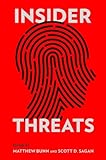Insider Threats / ed. by Scott D. Sagan, Matthew Bunn.
Material type: TextSeries: Cornell Studies in Security AffairsPublisher: Ithaca, NY : Cornell University Press, [2017]Copyright date: ©2017Description: 1 online resource (216 p.) : 1 halftone, 3 tables, 6 chartsContent type:
TextSeries: Cornell Studies in Security AffairsPublisher: Ithaca, NY : Cornell University Press, [2017]Copyright date: ©2017Description: 1 online resource (216 p.) : 1 halftone, 3 tables, 6 chartsContent type: - 9781501705946
- Nuclear terrorism -- Prevention -- United States
- Nuclear terrorism -- Prevention
- Terrorism -- Prevention -- United States
- Terrorism -- United States -- Prevention
- International Studies
- Political Science & Political History
- POLITICAL SCIENCE / Security (National & International)
- terrorism prevention, preventing terrorism, preventing nuclear terrorism, terrorist threats to nuclear facilities, fort hood terrorist attack, anthrax letters, what was the threat in afghanistan, insider threats, what is an insider threat, international security, national security
- 658.4/73 22
- HV6432
- online - DeGruyter
| Item type | Current library | Call number | URL | Status | Notes | Barcode | |
|---|---|---|---|---|---|---|---|
 eBook
eBook
|
Biblioteca "Angelicum" Pont. Univ. S.Tommaso d'Aquino Nuvola online | online - DeGruyter (Browse shelf(Opens below)) | Online access | Not for loan (Accesso limitato) | Accesso per gli utenti autorizzati / Access for authorized users | (dgr)9781501705946 |
Frontmatter -- Contents -- Contributors -- Acknowledgments -- Introduction: Inside the Insider Threat -- 1. Insiders and Outsiders: A Survey of Terrorist Threats to Nuclear Facilities -- 2. The Fort Hood Terrorist Attack: An Organizational Postmortem of Army and FBI Deficiencies -- 3. Lessons from the Anthrax Letters -- 4. Green-on-Blue Violence: A First Look at Lessons from the Insider Threat in Afghanistan -- 5. Preventing Insider Theft: Lessons from the Casino and Pharmaceutical Industries -- 6. A Worst Practices Guide to Insider Threats -- Index
restricted access online access with authorization star
http://purl.org/coar/access_right/c_16ec
‹p›‹b›"This compendium of research on insider threats is essential reading for all personnel with accountabilities for security; it shows graphically the extent and persistence of the threat that all organizations face and against which they must take preventive measures."‹/b›- Roger Howsley, Executive Director, World Institute for Nuclear Security‹/p›‹p›High-security organizations around the world face devastating threats from insiders—trusted employees with access to sensitive information, facilities, and materials. From Edward Snowden to the Fort Hood shooter to the theft of nuclear materials, the threat from insiders is on the front page and at the top of the policy agenda. ‹b›‹i›Insider Threats‹/i›‹/b› offers detailed case studies of insider disasters across a range of different types of institutions, from biological research laboratories, to nuclear power plants, to the U.S. Army. Matthew Bunn and Scott D. Sagan outline cognitive and organizational biases that lead organizations to downplay the insider threat, and they synthesize "worst practices" from these past mistakes, offering lessons that will be valuable for any organization with high security and a lot to lose.‹/p›‹p›Insider threats pose dangers to anyone who handles information that is secret or proprietary, material that is highly valuable or hazardous, people who must be protected, or facilities that might be sabotaged. This is the first book to offer in-depth case studies across a range of industries and contexts, allowing entities such as nuclear facilities and casinos to learn from each other. It also offers an unprecedented analysis of terrorist thinking about using insiders to get fissile material or sabotage nuclear facilities.‹/p›‹p›Contributors: Matthew Bunn, Harvard University; Andreas Hoelstad Dæhli, Oslo; Kathryn M. Glynn, IBM Global Business Services;Thomas Hegghammer, Norwegian Defence Research Establishment, Oslo; Austin Long, Columbia University; Scott D. Sagan, Stanford University; Ronald Schouten, Massachusetts General Hospital and Harvard Medical School; Jessica Stern, Harvard University; Amy B. Zegart, Stanford University‹/p›
Mode of access: Internet via World Wide Web.
In English.
Description based on online resource; title from PDF title page (publisher's Web site, viewed 26. Apr 2024)


